Q&A: ‘We have to be worried’ about decline in measles vaccination
Key takeaways:
- Measles is one of the most transmissible infections in humans.
- In 2024, there have been 277 cases of measles in 31 states and Washington, D.C.
- Kindergarten vaccination rates dropped below 93% in the U.S.
NEW YORK — As vaccination coverage declines globally, pediatricians need to prepare to encounter more measles cases in their communities, according to a presentation at the Infectious Diseases in Children Symposium.

In her talk, “Get Ready for Measles,” Yvonne “Bonnie” A. Maldonado, MD, described how measles impacted children before a vaccine was developed, common presentations and complications of measles, and what the future may look like as vaccination coverage erodes in the United States and globally.

According to the CDC and WHO’s latest global measles report, measles cases increased 20% in 2023 globally and 37% in Africa. Officials blamed the increase on “stalled” vaccine coverage. An estimated 22.2 million children missed their first dose of measles vaccine in 2023, according to the report.
“We are seeing a steady decline of vaccination,” Maldonado, the Taube Professor of Global Health and Infectious Diseases and professor of pediatric infectious diseases and epidemiology and population health at Stanford University School of Medicine, told Healio. “It is not horrific yet, but we have to be worried about it.”
Healio spoke with Maldonado about what pediatricians need to know about measles and measles vaccination.
Healio: What are the complications of measles?
Maldonado: Measles is still a major global cause of disease and death, especially among infants and young children. In the late 80s and early 90s, about 1 million children were dying from measles each year across the globe. In 2018, more than 140,000 children died of measles, most aged younger than 5 years. The most common cause of death is measles-related pneumonia.
The major complications that we see include encephalitis, a brain infection that occurs in about one in 1,000 measles cases. Pneumonia is very common; it happens in about 6% of kids. Diarrhea can happen in about 8% of kids. About 20% of kids can be hospitalized from measles, and death occurs in about one to three per 1,000 cases. It can also cause miscarriages, preterm birth or preterm labor in nonimmune pregnant women. People who are immunocompromised, especially people with a lack of T-cell immunity, are at high risk for severe disease and death.
Healio: What trends are you seeing in measles cases?
Maldonado: In 2000, measles was declared to be eliminated in the United States, meaning there was no circulation of this disease in the population. Since then, we have seen a bump in cases in the U.S. Around 2011, we started to see little blips of measles cases that we did not see from 2000 to 2010. We saw more than 600 cases in 2014 in the U.S., almost 400 in 2018 and then in 2019 we had over 1,200 cases confirmed in 31 states. That was the greatest number of cases reported in the U.S. since 1992, and we almost lost the measles elimination status that we have had since 2000. We managed to get that number down, primarily through enhanced messaging about vaccination.
The number of cases has dropped off since 2019, but now we are seeing another blip in 2024. As of mid-November, we had 277 cases of measles in 31 states and the District of Columbia. Fourteen outbreaks were associated with 70% of those cases. We think this is related to a lack of vaccination because 88% of cases this year were in unvaccinated people.
Our concern is that, because measles is so infectious, more and larger outbreaks could rapidly occur with more unvaccinated children.
Healio: What do vaccination rates look like now?
Maldonado: During the 2023-2024 school year, kindergartners in the U.S. had a reduction in coverage for the measles, mumps and rubella vaccine, as well as for diphtheria, tetanus and pertussis vaccine from 92.7% to 92.3%. It decreased in more than 30 states compared with coverage the year before. The number of kindergartners attending school last year without completing the MMR was about 280,000 kids, so that's a lot of children who are at risk. They tend to be in pockets, so you worry about an introduction in those areas that could sustain an outbreak. We also saw that the rate of exemptions for one or more vaccines, not just measles, increased from 3% the year before to 3.3%. They increased in 40 states and in the District of Columbia, with 14 states reporting exemptions that exceeded 5%. The number of kindergartners exempt from one or more vaccines last year was about a 127,000.
Healio: Are there certain states or regions we should be concerned about?
Maldonado: I do not like to target places because it lulls us into a false sense of security. The fact that 30 states had outbreaks and 40 states had increased levels of exemptions, including the District of Columbia, tells me that pretty much every state is at risk. What we need to do is enhance and support the public perception of measles as a serious illness that we need to take seriously. People say, ‘Well, we don't have measles, so why should I care?’ But we don't have it because we are vaccinating against it!
One of the things we try to do is help pediatricians understand how to explain to families how important these diseases are, how important they used to be and how we still need to protect ourselves. The AAP and CDC have resources on their websites around vaccine communication.
For more information:
Yvonne “Bonnie” A. Maldonado, MD, can be reached at bonniem@stanford.edu.
Reference:
- Maldonado Y. Get ready for measles. Presented at: Infectious Diseases in Children Symposium; Nov. 16-17, 2023; New York.
- CDC. Measles cases and outbreaks. https://www.cdc.gov/measles/data-research/index.html. Updated Nov. 8, 2024. Accessed Nov. 16, 2024.

